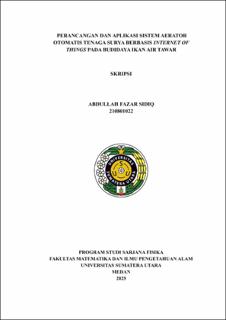| dc.description.abstract | This study presented the development of an automatic aerator system based on the
Internet of Things (IoT) and powered by solar energy, which was designed to improve
water quality in freshwater aquaculture. The system utilized an Arduino Mega 2560
microcontroller integrated with several water quality sensors, including dissolved
oxygen (DO), pH, temperature (DS18B20), total dissolved solids (TDS), and turbidity.
Sensor data were processed to automatically control a venturi-type aerator based on
DO threshold levels, wherein the aerator was activated when DO was ≤ 5 ppm and
deactivated when DO was ≥ 5 ppm. The system was powered by a solar panel as the
primary energy source, supported by a solar charge controller and a rechargeable
battery for energy storage. Additionally, Wi-Fi connectivity was enabled using the
ESP8266 module, allowing for remote monitoring through an Android-based
application developed using MIT App Inventor. The development process involved both
hardware and software design, sensor calibration, module integration, and direct field
performance testing. During operation, the system functioned autonomously and
efficiently, requiring users only to power on the device and monitor real-time data via
an LCD display or mobile application. Experimental results indicated that the system
achieved an accuracy rate of up to 99% and effectively maintained water quality
within optimal thresholds. Furthermore, the implementation of solar energy
significantly reduced reliance on conventional electricity. Overall, the system provided
an efficient, sustainable, and environmentally friendly solution to support and enhance
productivity in freshwater aquaculture. | en_US |


